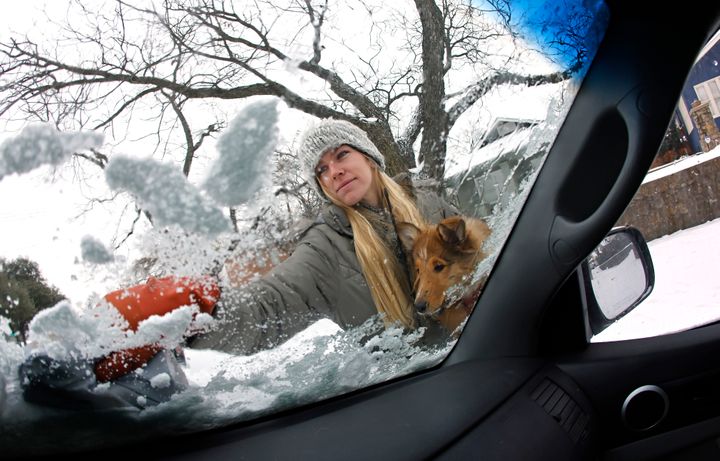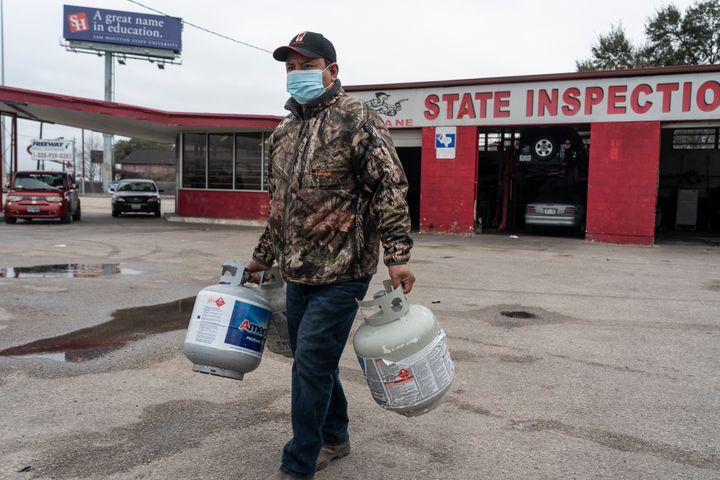News
How To Stay Warm At Home When Your Power Is Out
The deadly winter storm this week left millions of Americans without power and heat in frigid temperatures ― a situation that carries the risk of hypothermia, carbon monoxide poisoning and frostbite among other dangers.
While there are warming stations throughout hard-hit places like Texas, many are still riding out the icy aftermath in their homes. If you find yourself at home without power, there are ways to increase your safety and comfort.
HuffPost spoke to experts about safely managing this situation at home. Here’s what you need to know about staying warm in your house amid a winter power and heat outage.
Insulate your home.
It’s important to keep warmth inside your home and keep the cold out.
“Openings like windows and exterior doors are the typical culprits where you’re going to lose heat in your home,” said Leslie Chapman-Henderson, president and CEO of the Federal Alliance for Safe Homes,a nonprofit dedicated to promoting disaster safety and preparedness. “Obviously you may not have tubes of caulk handy, but you can use packing tape or even towels to seal those cracks and prevent heat from leaving your house.”
You can also use blankets, bubble wrap, clothing, plastic or cardboard to cover cold air entryways. Pushing furniture against the exterior walls may also help.
The National Weather Service also recommends closing curtains and blinds to keep more heat inside.
Designate a living area.
“Move all activities to a main room and close the remaining interior doors to retain heat,” the NWS in Kansas City, Missouri, advised in a graphic on Twitter.
Make sure that main living space has the things you need, like flashlights, batteries, blankets, sleeping bags, medications and snacks.
“A tent can be set up in the middle of the living area to create a microenvironment,” said Kylene Jones, co-author of “The Provident Prepper: A Common-Sense Guide to Preparing for Emergencies” and its accompanying blog. “You will stay much warmer inside of the tent. You can also create a makeshift tent, so get creative.”
Be mindful when choosing which room to designate, Chapman-Henderson advised.
“Get as far away from those spaces that have the most windows and doors as possible to find the warmest spots,” she said. “You can probably tell where you’re the most energy efficient in your house ― rooms with fewer windows or where you’ve more recently re-caulked your windows.”
Layer your clothes.
In addition to insulating your home, you need to insulate your body to retain warmth.
“Wear comfortable, loose-fitting, lightweight clothing in layers,” Chapman-Henderson said. “The bottom layer should be comfy, maybe cotton, and then layer wool or flannel on top of that. And then if you want to stay warm and dry, add a jacket that’s water-resistant.”
She also advised wearing a hat and warm socks and footwear to prevent body heat from escaping from your head or extremities. Mittens and a scarf are also helpful. And in the pandemic era, face masks can provide extra warmth as well.
“It may feel odd inside your home, but this is key for retaining your body heat, basically sealing in your body heat,” Chapman-Henderson noted. “Once your feet are cold, it’s hard to warm them up.”
Be careful with alternative heat.
“Don’t do anything that may potentially expose you to carbon monoxide!” cautioned Jones.
If you have an alternative way to provide heat, make sure that it is safe to use inside your home. Portable table heaters and camping heaters aren’t always meant for indoor use and may require extra ventilation. Jones advised a propane heater that is rated for indoor use.
“Ideally, you will want to confine emergency heating to one room in your home,” she added.
If you decide to seek warmth in your car, be sure to clear snow from the exhaust pipe, run the motor for just 10 minutes each hour to get some heat and keep the window slightly open to avoid carbon monoxide poisoning. The CDC warns against running a car inside a garage attached to your house, even if the door is open.
Be careful to keep your heater away from anything flammable that could pose a fire risk. If you have a generator, make sure it’s in a safe, well-ventilated location and properly connected to avoid dangerous backfeeding.
The NWS also suggests lighting your wood-burning or gas fireplace if that’s an option. Candles can also provide a little bit of heat. As always, be mindful of fire safety.
“We found that candles were not a safe idea. We had little children and they kept sticking flammable items in the flame,” Jones recalled of her family’s winter power outage experience. “Pets can also be fascinated by the flame and create a potential fire hazard.”
Stay dry.
“Hypothermia is a real risk even inside your home,” Jones noted. “Stay dry!”
Keep extra clothing in your space so that you can change out of any wet clothes as soon as possible. If you go outside, pay attention to snow that may get into your boots and mittens.
“Even if you have water, use wipes instead of showering,” Chapman-Henderson advised.
Short spurts of light exercise can also help you stay warm, but avoid movement that will cause you to sweat.
Eat and drink.
“Food provides the body with energy for producing its own heat,” the NWS website notes. “Drinks lots of water and other non-caffeinated, non-alcoholic drinks to prevent dehydration. Cold air is very dry.”
Try to eat foods that don’t require preparation, but if you need to cook, be mindful of food and appliance safety. In the aftermath of the recent winter storms, Texas residents have been advised not to drink tap water unless they can boil it.
With that in mind, Jones recommended acting fast in the moment of a storm and power outage.
“Minutes can make all of the difference when your power goes out in the winter,” she said. “Fill empty containers with water. Fill the bathtub with water, unless you have little ones or pets that a full bathtub might pose a drowning risk.”
Don’t try to bring an outdoor grill inside. Jones advised cooking with canned heat or a butane catering stove rated for indoor use.
“Avoid butane camping stoves that require ventilation to be safe,” she said. “You can even cook your food with candles if you have nothing else to use.”

Pay attention to local guidance.
“We’ve heard the way to prevent frozen pipes is wrapping or keeping the faucet dripping, but be sure to follow local advice,” Chapman-Henderson said. “In Texas, they’re telling people no more dripping because it’s affecting the water pressure, so everyone needs to stop.”
Local officials will provide updates on the latest developments, resources and recommendations for your community. They may also share information on warming centers should you require outside assistance. Citizens can also mobilize to help others in their communities.
“Check on neighbors or family members to make sure that they are safe,” Jones said. “This can be done simultaneously while gathering supplies and securing your home. The more people in a living area, the warmer it will be. Don’t hesitate to invite friends over and share the added warmth and companionship.”
Prepare for next time.
When disaster strikes, you may not have emergency response supplies on hand, but that doesn’t mean you can’t use it as a blueprint to prepare for a future challenge.
“Advanced preparation can make all the difference in your level of comfort and safety during a power outage,” Jones said. “Think about everything in your life that requires electricity in order to operate and plan accordingly. Basic necessities are the ability to cook, stay warm, light your world, and access clean drinking water.”
Make sure your home is equipped with good insulation and caulking. Install carbon monoxide detectors and smoke alarms. Keep up with routine maintenance.
In addition to an alternative indoor heat source, consider putting together a kit with supplies like flashlights, batteries, medicine, blankets, hand and foot warmers, hot water bottles, jumper cables, radios and even solar lighting devices that can be charged by the sun. Check out the camping aisles at sporting goods stores.
Update your kit to meet the needs of children and pets as well. Jones said she keeps at least two weeks’ worth of shelf-stable, easy-to-prepare food and a large supply of clean, safe drinking water.
“No matter where you live, you will confront some type of natural event that could disrupt your power,” Chapman-Henderson said. “The last thing we ever want to feel as humans is helpless, and we’re so dependent on our power supply, it being gone can wreak emotional havoc. Anything you can do to take back control and take care of your partner, children, pets and self makes a difference.

